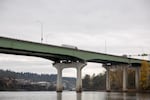Oregon transportation officials last week began unwinding a seven-year effort to toll Portland-area freeways, after Gov. Tina Kotek sent word she wanted to end or pause much of that work.
But in a lengthy hearing on Thursday, the Oregon Transportation Commission made clear it would leave the door open for tolling in the future. Lawmakers next year plan to pass a bill that will create a long-term plan to pay for highway upkeep and major construction projects.

Seismic upgrades on the Interstate 205 Abernethy Bridge, pictured here in 2018, are among projects that Oregon officials have planned to fund with tolls.
/ OPB
“The Legislature needs to decide if there is continued political will to move forward with tolling,” said Sharon Smith, an attorney from Bend who sits on the five-person commission. “I think once people start looking at the real numbers, it’s got to be a tool. It’s got to be on the table.”
To that end, the commission approved changes to a new four-year “strategic action plan” for the Oregon Department of Transportation that removes mention of tolls on Interstates 5 and 205 around Portland beginning in 2026. The plan gives direction to agency leaders about what they need to prioritize from today through 2028.
But the commission also left in place broader references to tolling as a tool that can pay for big construction projects and cut down on congestion, and signaled it was awaiting “legislative tolling direction.” Commissioners also made clear that a replacement for the Interstate Bridge on I-5 will move forward with tolls as a major source of funding.
ODOT Director Kris Strickler told commissioners his office would end a program that would have used tolls to manage congestion around Portland “at a very rapid rate” in order to save money. The agency says it’s spent more than $60 million to implement a tolling system in the state.
But a separate paused plan to pay for ongoing construction on the Abernethy Bridge on I-205 with toll revenue will need some additional work before wrapping up, Strickler said. That’s because ODOT wants to be sure it’s leaving the plan in place for the state to potentially pick back up in the future.
“We’re going to continue some of the work, or at least we plan to,” Strickler told the volunteer commissioners, adding: “We think that’s prudent. We think that’s responsible. We also understand the financial impact, so we’re not looking at spending millions of dollars there to do that, or at least tens of millions.”
Kotek’s decision to end work on years-long plans to toll Portland highways came after prolonged backlash from drivers who worried about new costs built into their daily travel, and from residents who feared a flood of new traffic in their neighborhoods to dodge those costs. Clackamas County Republicans had long decried the tolling proposal, but increasingly Democratic lawmakers were critical of the plan.
The decision, announced in a letter last week, also emerged after a state study revealed that tolls might need to be higher than expected in order to meaningfully curb congestion. The agency told lawmakers earlier this year that tolls as high as $5.60 on the Abernethy Bridge could be necessary if the goal of those tolls was to ease traffic jams on I-205, as opposed to funding construction.
Kotek told reporters last week that her decision “doesn’t mean tolling in itself as a mechanism shouldn’t be considered.”
“We got to this point where, if we’re going to spend more money to stand up the tolling infrastructure here in Oregon, we needed to have more certainty,” the governor said in her first public comments after the Legislature adjourned March 7. “We were planning to spend a lot of money to do that and, frankly, I didn’t think we knew we’d have the certainty to actually implement it.”
But the decision also creates questions about how the state will pay for ongoing megaprojects it’s committed to. That includes the Abernethy Bridge seismic retrofitting, which is underway, along with a plan to widen I-5 through Portland’s Rose Quarter.
Kotek said last week that lawmakers must figure out how to close funding gaps in those projects — via tolling or other means — before coming up with a new project wish list in the next transportation funding bill.
“I want to be really clear with legislators: We have to do the basics and commit [to] the projects that are in the queue before we start new projects,” Kotek said. “They’re going to have to figure out how to fund those things first before we talk about any new projects.”
Members of the Legislature’s Joint Transportation Committee plan to conduct hearings around the state before next year’s legislative session as they work on a plan to revamp road funding in Oregon.
